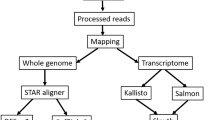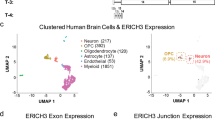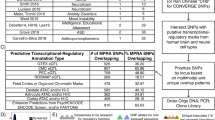Abstract
To identify genes that may be relevant to the molecular action of antidepressants, we investigated transcriptional changes induced by the selective serotonin reuptake inhibitor paroxetine in a serotonergic cell line. We examined gene expression changes after acute treatment with paroxetine and sought to validate microarray results by quantitative PCR (qPCR). Concordant transcriptional changes were confirmed for 14 genes by qPCR and five of these, including the adrenomedullin gene (Adm), either approached or reached statistical significance. Reporter gene assays showed that a SNP (rs11042725) in the upstream flanking region of ADM significantly altered expression. Association analysis demonstrated rs11042725 to be significantly associated with response to paroxetine (odds ratio=0.075, P<0.001) but not with response to either fluoxetine or citalopram. Our results suggest that ADM is involved with the therapeutic efficacy of paroxetine, which may have pharmacogenetic utility.
This is a preview of subscription content, access via your institution
Access options
Subscribe to this journal
Receive 6 print issues and online access
$259.00 per year
only $43.17 per issue
Buy this article
- Purchase on Springer Link
- Instant access to full article PDF
Prices may be subject to local taxes which are calculated during checkout


Similar content being viewed by others
Accession codes
References
Schloss P, Henn FA . New insights into the mechanisms of antidepressant therapy. Pharmacol Ther 2004; 102: 47–60.
Quitkin FM, McGrath PJ, Stewart JW, Taylor BP, Klein DF . Can the effects of antidepressants be observed in the first two weeks of treatment? Neuropsychopharmacology 1996; 15: 390–394.
Posternak MA, Zimmerman M . Is there a delay in the antidepressant effect? A meta-analysis. J Clin Psychiatry 2005; 66: 148–158.
Haynes LE, Barber D, Mitchell IJ . Chronic antidepressant medication attenuates dexamethasone-induced neuronal death and sublethal neuronal damage in the hippocampus and striatum. Brain Res 2004; 1026: 157–167.
Kato M, Fukuda T, Serretti A, Wakeno M, Okugawa G, Ikenaga Y et al. ABCB1 (MDR1) gene polymorphisms are associated with the clinical response to paroxetine in patients with major depressive disorder. Prog Neuropsychopharmacol Biol Psychiatry 2008; 32: 398–404.
Gratacos M, Soria V, Urretavizcaya M, Gonzalez JR, Crespo JM, Bayes M et al. A brain-derived neurotrophic factor (BDNF) haplotype is associated with antidepressant treatment outcome in mood disorders. Pharmacogenomics J 2008; 8: 101–112.
Wilkie MJ, Smith G, Day RK, Matthews K, Smith D, Blackwood D et al. Polymorphisms in the SLC6A4 and HTR2A genes influence treatment outcome following antidepressant therapy. Pharmacogenomics J 2008; 9: 61–70.
Ham BJ, Lee BC, Paik JW, Kang RH, Choi MJ, Choi IG et al. Association between the tryptophan hydroxylase-1 gene A218C polymorphism and citalopram antidepressant response in a Korean population. Prog Neuropsychopharmacol Biol Psychiatry 2007; 31: 104–107.
Ehret MJ, Levin GM, Narasimhan M, Rathinavelu A . Venlafaxine induces P-glycoprotein in human Caco-2 cells. Hum Psychopharmacol 2007; 22: 49–53.
Dias BG, Banerjee SB, Duman RS, Vaidya VA . Differential regulation of brain derived neurotrophic factor transcripts by antidepressant treatments in the adult rat brain. Neuropharmacology 2003; 45: 553–563.
Iga J, Ueno S, Yamauchi K, Motoki I, Tayoshi S, Ohta K et al. Serotonin transporter mRNA expression in peripheral leukocytes of patients with major depression before and after treatment with paroxetine. Neurosci Lett 2005; 389: 12–16.
Di Lieto A, Leo D, Volpicelli F, di Porzio U, Colucci-D’Amato L . FLUOXETINE modifies the expression of serotonergic markers in a differentiation-dependent fashion in the mesencephalic neural cell line A1 mes c-myc. Brain Res 2007; 1143: 1–10.
White LA, Eaton MJ, Castro MC, Klose KJ, Globus MY, Shaw G et al. Distinct regulatory pathways control neurofilament expression and neurotransmitter synthesis in immortalized serotonergic neurons. J Neurosci 1994; 14: 6744–6753.
Lundberg J, Odano I, Olsson H, Halldin C, Farde L . Quantification of 11C-MADAM binding to the serotonin transporter in the human brain. J Nucl Med 2005; 46: 1505–1515.
Bel N, Artigas F . Fluvoxamine preferentially increases extracellular 5-hydroxytryptamine in the raphe nuclei: an in vivo microdialysis study. Eur J Pharmacol 1992; 229: 101–103.
Malagie I, Trillat AC, Jacquot C, Gardier AM . Effects of acute fluoxetine on extracellular serotonin levels in the raphe: an in vivo microdialysis study. Eur J Pharmacol 1995; 286: 213–217.
Giovacchini G, Lang L, Ma Y, Herscovitch P, Eckelman WC, Carson RE . Differential effects of paroxetine on raphe and cortical 5-HT1A binding: a PET study in monkeys. Neuroimage 2005; 28: 238–248.
Lau T, Horschitz S, Berger S, Bartsch D, Schloss P . Antidepressant-induced internalization of the serotonin transporter in serotonergic neurons. FASEB J 2008; 22: 1702–1714.
Savas HA, Herken H, Yurekli M, Uz E, Tutkun H, Zoroglu SS et al. Possible role of nitric oxide and adrenomedullin in bipolar affective disorder. Neuropsychobiology 2002; 45: 57–61.
Zoroglu SS, Herken H, Yurekli M, Uz E, Tutkun H, Savas HA et al. The possible pathophysiological role of plasma nitric oxide and adrenomedullin in schizophrenia. J Psychiatr Res 2002; 36: 309–315.
Zoroglu SS, Yurekli M, Meram I, Sogut S, Tutkun H, Yetkin O et al. Pathophysiological role of nitric oxide and adrenomedullin in autism. Cell Biochem Funct 2003; 21: 55–60.
Morey JS, Ryan JC, Van Dolah FM . Microarray validation: factors influencing correlation between oligonucleotide microarrays and real-time PCR. Biol Proced Online 2006; 8: 175–193.
Rajeevan MS, Vernon SD, Taysavang N, Unger ER . Validation of array-based gene expression profiles by real-time (kinetic) RT-PCR. J Mol Diagn 2001; 3: 26–31.
Boyer J, Allen WL, McLean EG, Wilson PM, McCulla A, Moore S et al. Pharmacogenomic identification of novel determinants of response to chemotherapy in colon cancer. Cancer Res 2006; 66: 2765–2777.
Grade M, Hormann P, Becker S, Hummon AB, Wangsa D, Varma S et al. Gene expression profiling reveals a massive, aneuploidy-dependent transcriptional deregulation and distinct differences between lymph node-negative and lymph node-positive colon carcinomas. Cancer Res 2007; 67: 41–56.
Liew KJ, Chow VT . Microarray and real-time RT-PCR analyses of a novel set of differentially expressed human genes in ECV304 endothelial-like cells infected with dengue virus type 2. J Virol Methods 2006; 131: 47–57.
Zebedee Z, Hara E . Id proteins in cell cycle control and cellular senescence. Oncogene 2001; 20: 8317–8325.
Lasorella A, Uo T, Iavarone A . Id proteins at the cross-road of development and cancer. Oncogene 2001; 20: 8326–8333.
Drigues N, Poltyrev T, Bejar C, Weinstock M, Youdim MB . cDNA gene expression profile of rat hippocampus after chronic treatment with antidepressant drugs. J Neural Transm 2003; 110: 1413–1436.
Tohda M, Hayashi H, Sukma M, Tanaka K . BNIP-3: a novel candidate for an intrinsic depression-related factor found in NG108-15 cells treated with Hochu-ekki-to, a traditional oriental medicine, or typical antidepressants. Neurosci Res 2008; 62: 1–8.
Pernar L, Curtis AL, Vale WW, Rivier JE, Valentino RJ . Selective activation of corticotropin-releasing factor-2 receptors on neurochemically identified neurons in the rat dorsal raphe nucleus reveals dual actions. J Neurosci 2004; 24: 1305–1311.
Clark MS, McDevitt RA, Hoplight BJ, Neumaier JF . Chronic low dose ovine corticotropin releasing factor or urocortin II into the rostral dorsal raphe alters exploratory behavior and serotonergic gene expression in specific subregions of the dorsal raphe. Neuroscience 2007; 146: 1888–1905.
Henry B, Vale W, Markou A . The effect of lateral septum corticotropin-releasing factor receptor 2 activation on anxiety is modulated by stress. J Neurosci 2006; 26: 9142–9152.
Miyashita K, Itoh H, Arai H, Suganami T, Sawada N, Fukunaga Y et al. The neuroprotective and vasculo-neuro-regenerative roles of adrenomedullin in ischemic brain and its therapeutic potential. Endocrinology 2006; 147: 1642–1653.
Fernandez AP, Serrano J, Tessarollo L, Cuttitta F, Martinez A . Lack of adrenomedullin in the mouse brain results in behavioral changes, anxiety, and lower survival under stress conditions. Proc Natl Acad Sci USA 2008; 105: 12581–12586.
Kakiuchi C, Ishiwata M, Nanko S, Ozaki N, Iwata N, Umekage T et al. Up-regulation of ADM and SEPX1 in the lymphoblastoid cells of patients in monozygotic twins discordant for schizophrenia. Am J Med Genet B Neuropsychiatr Genet 2008; 147B: 557–564.
Fava M . Diagnosis and definition of treatment-resistant depression. Biol Psychiatry 2003; 53: 649–659.
Rush AJ, Trivedi MH, Carmody TJ, Ibrahim HM, Markowitz JC, Keitner GI et al. Self-reported depressive symptom measures: sensitivity to detecting change in a randomized, controlled trial of chronically depressed, nonpsychotic outpatients. Neuropsychopharmacology 2005; 30: 405–416.
Datto CJ, Thompson R, Knott K, Katz IR . Older adult report of change in depressive symptoms as a treatment decision tool. J Am Geriatr Soc 2006; 54: 627–631.
Lohmueller KE, Pearce CL, Pike M, Lander ES, Hirschhorn JN . Meta-analysis of genetic association studies supports a contribution of common variants to susceptibility to common disease. Nat Genet 2003; 33: 177–182.
Ioannidis JP, Ntzani EE, Trikalinos TA, Contopoulos-Ioannidis DG . Replication validity of genetic association studies. Nat Genet 2001; 29: 306–309.
Ioannidis JP, Trikalinos TA, Ntzani EE, Contopoulos-Ioannidis DG . Genetic associations in large versus small studies: an empirical assessment. Lancet 2003; 361: 567–571.
Sullivan PF . Spurious genetic associations. Biol Psychiatry 2007; 61: 1121–1126.
Balaji J, Desai R, Kaushalya SK, Eaton MJ, Maiti S . Quantitative measurement of serotonin synthesis and sequestration in individual live neuronal cells. J Neurochem 2005; 95: 1217–1226.
Vandesompele J, De Preter K, Pattyn F, Poppe B, Van Roy N, De Paepe A et al. Accurate normalization of real-time quantitative RT-PCR data by geometric averaging of multiple internal control genes. Genome Biol 2002; 3: RESEARCH0034.
Andersen CL, Jensen JL, Orntoft TF . Normalization of real-time quantitative reverse transcription-PCR data: a model-based variance estimation approach to identify genes suited for normalization, applied to bladder and colon cancer data sets. Cancer Res 2004; 64: 5245–5250.
Ciulla TA, Sklar RM, Hauser SL . A simple method for DNA purification from peripheral blood. Anal Biochem 1988; 174: 485–488.
Joyce PR, Light KJ, Rowe SL, Kennedy MA . Bipolar disorder not otherwise specified: comparison with bipolar disorder I/II and major depression. Aust N Z J Psychiatry 2007; 41: 843–849.
Sheehan DV, Lecrubier Y, Sheehan KH, Amorim P, Janavs J, Weiller E et al. The Mini-International Neuropsychiatric Interview (M.I.N.I.): the development and validation of a structured diagnostic psychiatric interview for DSM-IV and ICD-10. J Clin Psychiatry 1998; 59 (Suppl 20): 22–33; quiz 34–57.
Hirschfeld RM, Calabrese JR, Weissman MM, Reed M, Davies MA, Frye MA et al. Screening for bipolar disorder in the community. J Clin Psychiatry 2003; 64: 53–59.
Joyce PR, McHugh PC, Light KJ, Rowe S, Miller AL, Kennedy MA . Relationships between angry-impulsive personality traits and genetic polymorphisms of the dopamine transporter. Biol Psychiatry 2009 April 14 (e-pub ahead of print).
Acknowledgements
This research was supported by the Health Research Council of NZ and University of Otago. RN46A cells were a kind gift from Scott Whittemore, Laboratory of Molecular Neurobiology, Louisville, Kentucky, USA. Genotyping data were formatted into Paradox by Sarah Rowe, Department of Psychological Medicine, University of Otago, Christchurch.
Author information
Authors and Affiliations
Corresponding author
Additional information
Conflict of Interest
The authors declare no conflict of interest.
Supplementary Information accompanies the paper on the The Pharmacogenomics Journal website (http://www.nature.com/tpj)
Supplementary information
Rights and permissions
About this article
Cite this article
Glubb, D., McHugh, P., Deng, X. et al. Association of a functional polymorphism in the adrenomedullin gene (ADM) with response to paroxetine. Pharmacogenomics J 10, 126–133 (2010). https://doi.org/10.1038/tpj.2009.33
Received:
Revised:
Accepted:
Published:
Issue Date:
DOI: https://doi.org/10.1038/tpj.2009.33
Keywords
This article is cited by
-
Transcriptional analysis of sodium valproate in a serotonergic cell line reveals gene regulation through both HDAC inhibition-dependent and independent mechanisms
The Pharmacogenomics Journal (2021)
-
TOXPO: TOXicogenomics knowledgebase for inferring toxicity based on POlymorphism
BioChip Journal (2010)



